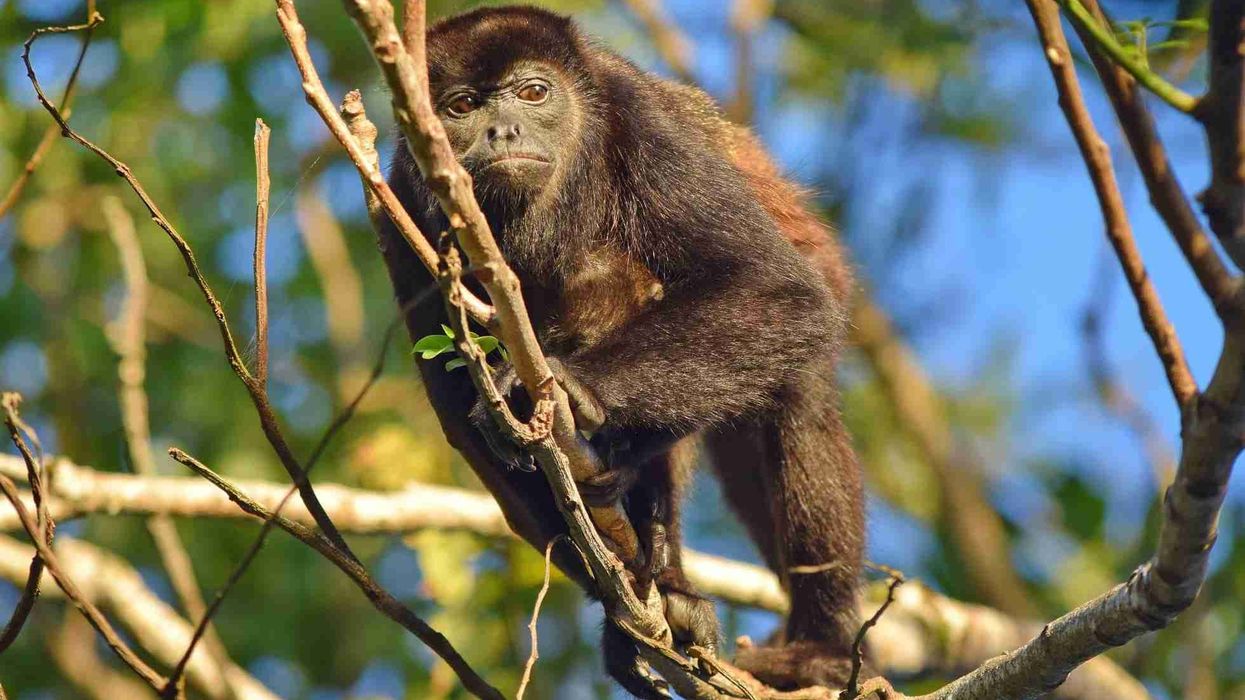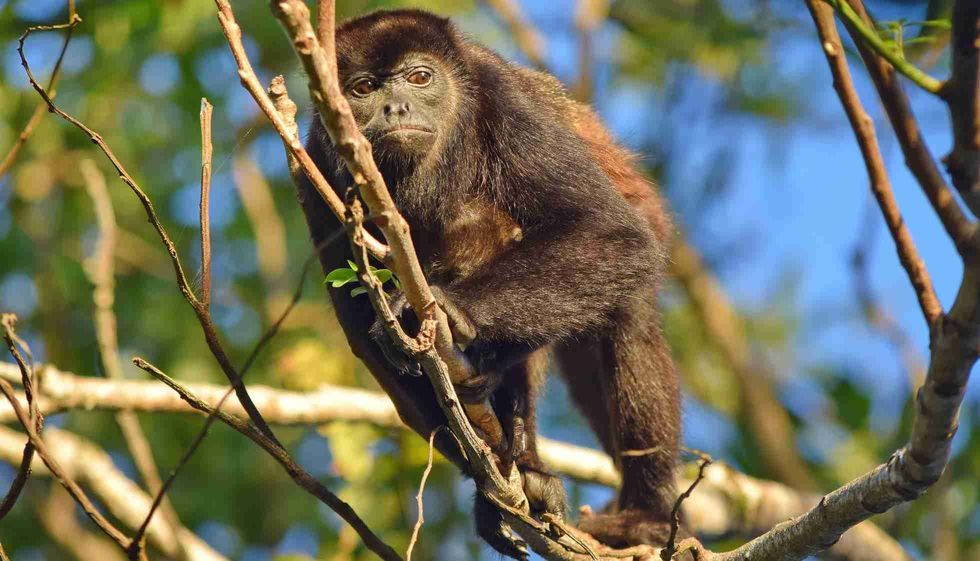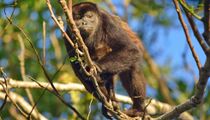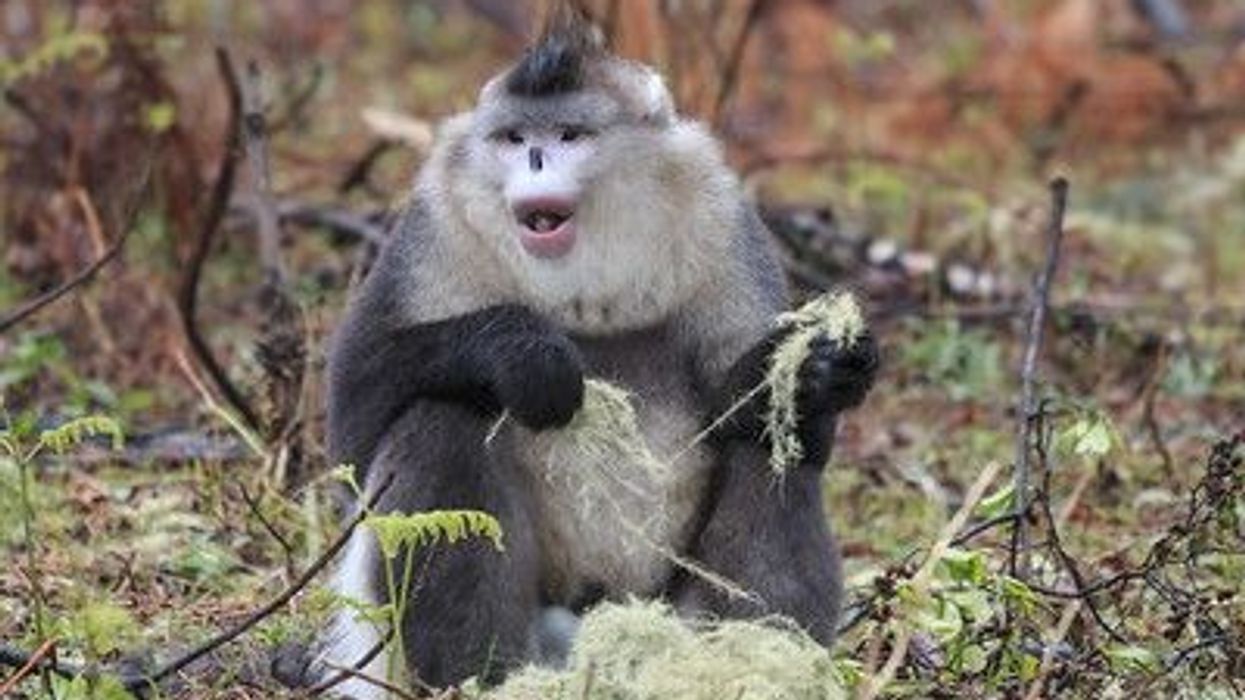Fun Mantled Howler Monkey Facts For Kids
Do you like reading about apes and monkeys? Then these fun Mantled howler monkey facts will be best for you.
Mantled howler monkey (Alouatta palliata) is a primate species. They have black thick fur all over the body except for their guard hairs which are yellow or golden-brown in coloration. Adult males are bigger in height and weight than adult females.
They live in a large group following a social hierarchy with the strongest adult males as alphas. They have a long gestation period and the average litter size is one which makes it very hard for them to increase their population very quickly. This is also a reason behind their depletion in population.
They are listed as Vulnerable in the IUCN Red List Of Threatened Species. To know more about these primates keep reading ahead.
If you like reading about various mammals, check out these Tamarin monkey facts and Titi monkey facts.
Mantled Howler Monkey Interesting Facts
What type of animal is a Mantled howler monkey?
The Mantled howler monkey (Alouatta palliata) is a kind of new world monkey species or primates.
What class of animal does a Mantled howler monkey belong to?
Mantled howler monkeys belong to the Mammalia class of animals.
How many Mantled howler monkeys are there in the world?
Mantled howler monkeys have an alarmingly declining population. According to a famous biologist Liliana Cortés Ortiz, their individual primate population to just a little over 11,000 in total. Among these only 1300 are in the protected areas and the rest 10,200 were in the unprotected areas.
Where does a Mantled howler monkey live?
Mantled howler monkeys are found in Southern Mexico in states like Veracruz, Chiapas, Costa Rica Tabasco, and Oaxaca. They are also commonly sighted in Central American states Honduras and Columbia in South America to southern Ecuador. Very few unconfirmed sightings have been reported in southern Guatemala.
What is a Mantled howler monkey's habitat?
Mantled howler monkeys are arboreal animals and thus live on the trees. So these new world monkeys prefer to live in the lowland and montane rainforest canopy or any forest canopy.
They are found in semi-deciduous forests, primary forests, and evergreen forests as well. These primates are very adaptable in nature and easily adapt to different habitat situations pretty well.
Who do Mantled howler monkeys live with?
Mantled howler monkeys live in large social groups of 15-20 individuals with more than three adult males and 5-10 adult females and their babies. Sometimes these groups can have over 40 members. The alpha of the group is the highest-ranked and gets primary mating rights. Females are outranked by males and young adults outrank older males.
How long does a Mantled howler monkey live?
In the wild, the Mantled howler monkeys have a lifespan of 15-20 years.
How do they reproduce?
Mantled howler monkeys are polygamous where one male copulates with multiple females. In most groups, the mating system is monopolized by the alpha male.
In some groups, low-ranking males are given equal mating opportunities. Females reach sexual maturity in 36 months and males reach their maturity and their testes descend at 42 months.
Females have regular estrus cycles of 16.3 days on average durations, females undergo some changes in the sexual parts at this time. Once a female is ready to mate they signal the males by a rhythmic tongue flickering or chemical signals and the male responds back in a similar manner and the mating begins.
The gestation period for these primates is 186 days and infants are born all year long. Females bear infants every 19-23 months.
What is their conservation status?
The IUCN has declared the status of these Mantled howler monkeys as Vulnerable due to their rapidly declining population. The biggest threat to these primates' survival is habitat loss due to deforestation, habitat fragmentation because of the urban development or economic activities of humans which also include illegal poaching and hunting.
These animals spend 90% of their time on trees and are quite awkward on land.
Several conservation steps have been taken to protect this primate species from going extinct. Several rainforest areas where they reside have been put under protection throughout Mexico, Central America, and South America.
These species have been listed under Appendix I of the CITES which prevents international trade of the species for commercial purposes since the Mantled howler monkeys are endemic and face the threat of extinction.
Mantled Howler Monkey Fun Facts
What do Mantled howler monkeys look like?
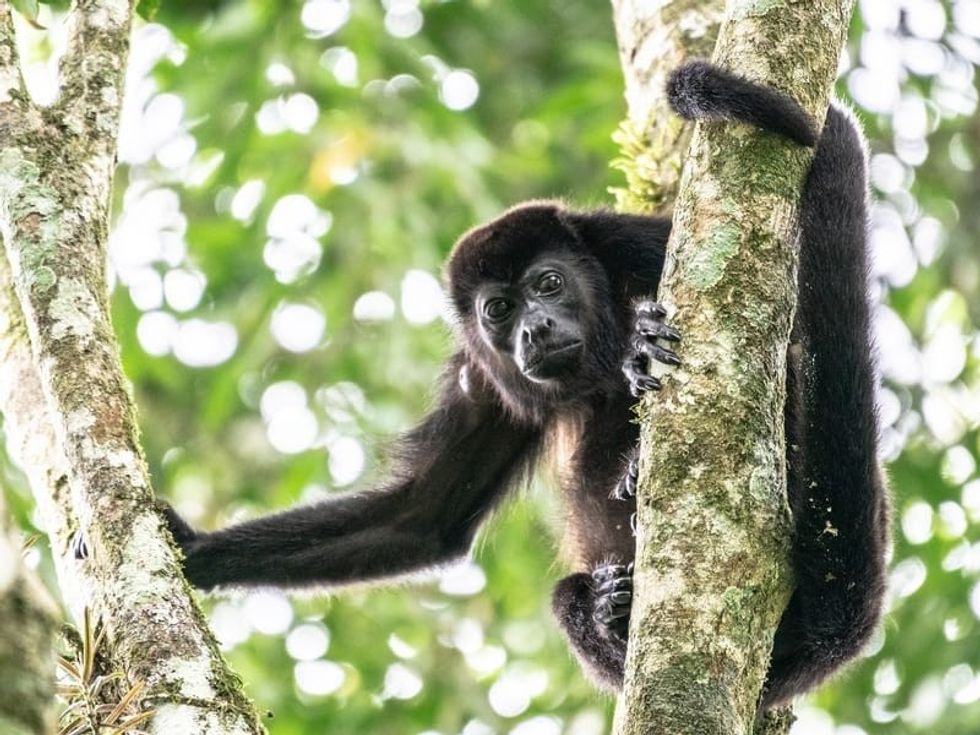
Mantled howler monkeys appear similar to other howler monkeys except their fur coloration is different due to their prominent guard hairs. They have prominent thick black fur all over their body with unique long yellow or golden-brown saddles.
They have long guard hairs on their side which give them their name 'mantled'. They have a black naked face, bearded underneath.
They have a prehensile tail which is generally longer than their body length and it also has a naked pad underside the base of the tail. The tail acts as a fifth limb for them helping them grasp and hold on to tree branches.
Males have a prominent white scrotum and comparatively longer beard than females and are also slightly bigger. An adult female is mostly seen with an infant on their chest or backs. A newborn infant is silver and then changes to a golden brown, the fur darkens as they grow.
How cute are they?
Unlike patas monkeys, Mantled howler monkeys can be considered quite cute and have become quite a popular choice for exotic pets in the US. They have adorable naked faces, especially the infants are very cute with their golden fur. As an exception to other primates, they are not aggressive in nature and live together in large social groups.
How do they communicate?
As per their name suggests, Mantled howler monkeys, they are called mantled howlers or mantled howling monkey as they howl to communicate with each other and vocal communication is their primary form of communication. Neighboring groups communicate with each other through loud vocal calls or howls.
They are the loudest new world monkeys since their calls can be heard up to 3 mi (4.8 km). Other sounds like woofing, barking, and grunting are also used for expressing different emotions amongst each other.
How big is a Mantled howler monkey?
The Mantled howler monkey is quite a big primate species. Males are bigger than females and reach a total body length of 41-53 in (104-134.6 cm). Females have a body length of 39-51 in (99-129.5 cm). They both have a prehensile tail almost as long as the length of their body.
The Mantled howler monkey isn't the largest howler monkey primate, the Guatemalan howler monkeys are much bigger than the Mantled howler monkeys.
How fast can a Mantled howler monkey jump?
The golden-mantled howling monkey species are arboreal and diurnal in nature. They move by using quadrupedalism (to walk or run with supports) using all four limbs, climbing, jumping, and bridging. They also use the strong and evolved prehensile tail to grab on or swing from a branch to another.
How much does a Mantled howler monkey weigh?
Male Mantled howler monkeys are heavier than their female counterparts. Males usually weigh 10-30 lb (4.5-13.6 kg) and females are in between 8-16 lb (3.5-7.3 kg).
What are the male and female names of the species?
There are no specific names for male and female monkeys in general. Thus, amongst Mantled howler monkeys they are simply referred to as male and female.
What would you call a baby Mantled howler monkey?
In general, monkey babies are called infants. A baby Mantled howler monkey is called an infant as well or a golden-mantled howling monkey as well.
What do they eat?
This new world monkey or primate Mantled howler monkey (Alouatta palliata) is a herbivore and enjoys feasting on flowers, fruits, and young leaves. They are very particular about the species of plant they feed on and they change their choices seasonally.
During the dry season, they like eating flowers as they are abundant, most of their preferred fruits are available in the wet season.
Ficus tree leaves and fruits are one of their most favorite food and are a major part of their diet. They also acquire most of their water requirements from young leaves to fruits, and flowers.
How active are they?
Mantled howler (Alouatta palliata) show diurnal behavior thus are only active during the day at night they sleep. They mostly spend their time walking, climbing, and running through the forest or rainforest canopy in search of fruits and flowers and females collect food for their infant.
They live in large social groups and follow a system of social hierarchy, so aggression amongst each other is also quite a rare sight. They have defensive behavior and give out loud calls when threatened.
They spend most of their time on trees climbing or sleeping. The rainforest fragmentation has made their movement and migration very difficult and thus has limited them to the protected areas.
Would they make a good pet?
Yes, they do make a good pet as they are quite an intelligent species of primates who are easily adjustable, peace-loving animals with a vegetarian diet. But they don't do well in captivity like cages or houses, they love jumping, climbing, and walking through trees.
Otherwise, they will become extremely lazy and sleep throughout the day.
They are not aggressive towards humans and there has been no case of a howler monkey killing a human but they are extremely loud.
So, if you have a large space with lots of trees and the ability to sustain their loud howls then they will become a very loving pet for you and your family. Their diet is very simple, consists of fruits and mostly leaves and flowers, but they do not eat bananas.
Did you know...
This species of howlers show a unique behavior, even though they are almost exclusively arboreal and only descend on the ground to search for water during extremely dry seasons, they are also quite accomplished swimmers and love bathing during summer seasons.
These primates are often hunted down by pumas, and Jaguars. The harpy eagles are their main predators.
Which country has howler monkeys?
Howler monkeys have different subspecies with a wide distribution. They are majorly found in Costa Rica and tropical Mexico where live in the tropical forest.
They inhabit the cloud forest, gallery forest, rainforest, and tropical dry forest in the Central American National parks like Corcovado National Park, Monteverde Cloud Forest Reserve, Santa Rosa National Park, and Manuel Antonio.
They are also found in the lowland and montane regions of South American in countries like Guatemala, Columbia, Panama, Ecuador (Ecuadorian mantled howlers are found here), and Costa Rica.
Why is the Mantled howler monkey endangered?
Mantled Howlers along with their several subspecies are either Endangered or Vulnerable and all of them share common threats, loss of habitat, and illegal hunting or poaching for the pet trade. This species of primates are extremely dependent on the forest for survival and basic needs.
Rapid urban development and pet trade have led them to remain secluded in the little forest that is left.
However, governments of countries like Mexico, Central America, and South America have listed them under the CITES appendix I to protect their extinction. This howler monkey (Alouatta palliata) and its subspecies are extremely important for the survival of the forest as well as their feces contain plant seeds which are essential for plant reproduction.
Here at Kidadl, we have carefully created lots of interesting family-friendly animal facts for everyone to discover! For more relatable content, check out these hamster facts and steller’s sea cow facts pages.
You can even occupy yourself at home by coloring in one of our free printable Mantled howler monkey coloring pages.
We Want Your Photos!
More for You
See All
Bachelor of Arts specializing in Journalism and Mass Communication, Postgraduate Diploma in Sports Management

Moumita DuttaBachelor of Arts specializing in Journalism and Mass Communication, Postgraduate Diploma in Sports Management
A content writer and editor with a passion for sports, Moumita has honed her skills in producing compelling match reports and stories about sporting heroes. She holds a degree in Journalism and Mass Communication from the Indian Institute of Social Welfare and Business Management, Calcutta University, alongside a postgraduate diploma in Sports Management.
Disclaimer
1) Kidadl is independent and to make our service free to you the reader we are supported by advertising. We hope you love our recommendations for products and services! What we suggest is selected independently by the Kidadl team. If you purchase using the Buy Now button we may earn a small commission. This does not influence our choices. Prices are correct and items are available at the time the article was published but we cannot guarantee that on the time of reading. Please note that Kidadl is a participant in the Amazon Services LLC Associates Program, an affiliate advertising program designed to provide a means for sites to earn advertising fees by advertising and linking to Amazon. We also link to other websites, but are not responsible for their content.
2) At Kidadl, we strive to recommend the very best activities and events. We will always aim to give you accurate information at the date of publication - however, information does change, so it’s important you do your own research, double-check and make the decision that is right for your family. We recognise that not all activities and ideas are appropriate for all children and families or in all circumstances. Our recommended activities are based on age but these are a guide. We recommend that these ideas are used as inspiration, that ideas are undertaken with appropriate adult supervision, and that each adult uses their own discretion and knowledge of their children to consider the safety and suitability. Kidadl cannot accept liability for the execution of these ideas, and parental supervision is advised at all times, as safety is paramount. Anyone using the information provided by Kidadl does so at their own risk and we can not accept liability if things go wrong.
3) Because we are an educational resource, we have quotes and facts about a range of historical and modern figures. We do not endorse the actions of or rhetoric of all the people included in these collections, but we think they are important for growing minds to learn about under the guidance of parents or guardians.
